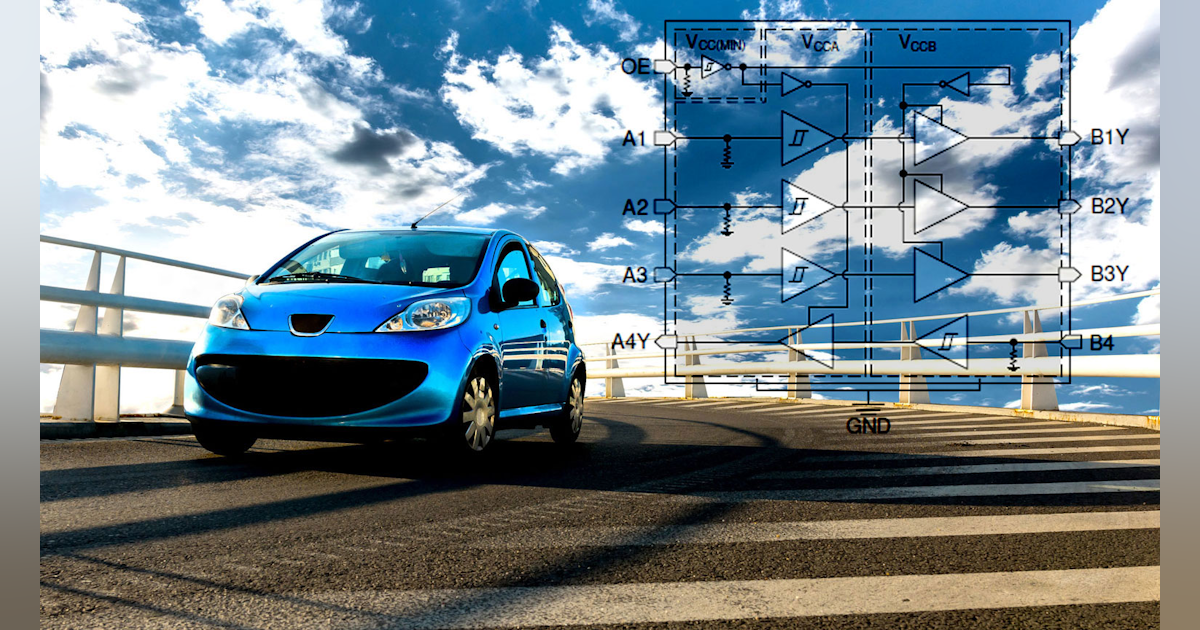
We’ve all seen this situation in designs with many functional blocks and ICs: There’s a component that doesn’t add a lot of signal-processing “value,” yet is nonetheless critical to successful circuit operation. That’s the case with level shifters and translators, whose task is to “merely” enable system subcircuits to properly interface with each other, yet not judge or modify the bit patterns passing through them. What they do is important and can often make the difference between a system with subfunctions that don’t “play well with others,” resulting in marginal or erratic performance, versus one with rock-solid operation.
Addressing such circuit-interface scenarios with disparate signal levels and drive is Texas Instruments’ TXU0304-Q1, an automotive-qualified, four-bit voltage-level translator (Fig. 1). This 14-pin device, available in two package styles, operates from two independent supplies (for input and output sides) and functions as a fixed-direction, noninverting, voltage-level translation unit. Three paths go in one direction while the fourth is in the reverse direction.
%{[ data-embed-type="image" data-embed-id="60df0f705b75a81e0c8b45e4" data-embed-element="span" data-embed-size="640w" data-embed-alt="1. Texas Instruments’ TXU0304-Q1 automotive-qualified, four-bit voltage-level translator can bridge the difference in signal levels between subcircuits." data-embed-src="https://ift.tt/3wi9w4x" data-embed-caption="1. Texas Instruments’ TXU0304-Q1 automotive-qualified, four-bit voltage-level translator can bridge the difference in signal levels between subcircuits." ]}%
By employing this IC, digital signals with incompatible levels can not only coexist, but they also can communicate at up to 200 Mb/s. Applications range from relatively slow cases like eliminating noisy input signals, driving indicator LEDs or buzzers, and debouncing mechanical switches, to much faster ones such as push-pull level shifting of GPIO, I2S, PCM, UART, SPI, and JTAG signals, among others (Fig. 2).
%{[ data-embed-type="image" data-embed-id="60df0f91fb363233008b4675" data-embed-element="span" data-embed-size="640w" data-embed-alt="2. Applications include slow mechanical signals as well as high-speed interfaces between GPS and SOC circuitry." data-embed-src="https://ift.tt/3xd3gww" data-embed-caption="2. Applications include slow mechanical signals as well as high-speed interfaces between GPS and SOC circuitry." ]}%
Each port can accept signals from 1.1 to 5.5 V. To enhance performance and improve resistance to noise associated with these slower signals, each input incorporates a Schmitt trigger. The inputs include pull-down resistors to ensure that channels aren’t “floating” (inputs left floating represent poor engineering practice and can lead to false signals—and even electrical damage).
In addition, the device includes a VCC isolation and VCC disconnect (Ioff-float) feature such that if either VCC input falls below 100 mV or disconnects, all outputs are disabled and become high-impedance nodes (Fig. 3). The output-side drive delivers up to 12 mA with a 5.5-V supply. Overall current requirements are just 3 µA maximum (at 25°C) and 6 µA maximum (−40 to 125°C).
%{[ data-embed-type="image" data-embed-id="60df0fa6f7b54835008b4690" data-embed-element="span" data-embed-size="640w" data-embed-alt="3. If the supply rail drops below 100 mV or disconnects, all outputs are disabled and become high-impedance nodes." data-embed-src="https://ift.tt/3hblSqU" data-embed-caption="3. If the supply rail drops below 100 mV or disconnects, all outputs are disabled and become high-impedance nodes." ]}%
Latch-up performance exceeds 100 mA (per JESD 78, class II), while ESD protection exceeds JESD 22 (per the 2500-V human-body model and 1500-V charged-device model). The TXU0304-Q1 is fully AEC-Q100-qualified for automotive applications and priced at $0.30 (1,000 pieces). The detailed 34-page datasheet provides full static and dynamic specifications and graphs along with a suggested PCB layout for optimum performance.
While a conventional component-laden evaluation kit doesn’t make sense for a product such as this one, potential users may still want to assess its suitability in their application. TI offers two bare, generic carrier PCBs to match the two available 14-lead housings of the TXU0304-Q1: the VQFN (3.00- × 2.50-mm footprint) package and TSSOP (5.00- × 4.40-mm footprint) package.
The 14-24-LOGIC-EVM is designed to support any logic device that has a D, DW, DB, NS, PW, P, N, or DGV package in a 14- to 24-pin count (Fig. 4a), while the 14-24-NL-LOGIC-EVM is for any logic or translation device in a BQA, BQB, RGY (also 14-to-24 pins), RSV, RJW, or RHL package (Fig. 4b). These boards have sections that can be broken apart for a smaller form factor.
%{[ data-embed-type="image" data-embed-id="60df0fbcf7b5487e038b4652" data-embed-element="span" data-embed-size="640w" data-embed-alt="4. These bare-bones, generic carrier PCBs allow users to test the two package styles of the TXU0304-Q1 voltage-level translator as an interface between two circuit functions and signal levels." data-embed-src="https://ift.tt/3x90sQV" data-embed-caption="4. These bare-bones, generic carrier PCBs allow users to test the two package styles of the TXU0304-Q1 voltage-level translator as an interface between two circuit functions and signal levels." ]}%
"interface" - Google News
July 02, 2021 at 08:19PM
https://ift.tt/3jIpenf
Level-Translator IC Performs Vital Interface Task for Automotive Systems - Electronic Design
"interface" - Google News
https://ift.tt/2z6joXy
https://ift.tt/2KUD1V2
Bagikan Berita Ini














0 Response to "Level-Translator IC Performs Vital Interface Task for Automotive Systems - Electronic Design"
Post a Comment